View from the Frauenkirche over the Castle and the Elbe.
Dresden, a pearl a the river Elbe in Germany, was the first stop of a 4 week Hoof Care Tour last month conducted by me, The Bootmeister from Global Endurance Training Center.
I have been going to Europe now for the last two years, sharing some gained hoof care and hoof protection Knowledge with riders, horse owners and farriers. The demand for more knowledge is high, people are eager to learn about Natural Hoof Care and the newest Hoof Protection products on the market. EasyCare is the undisputed leader in the world with research and development of hoof boots of all kinds. R&D is of utmost importance to the EasyCare staff. Horse owners worldwide know that. Hence, it is only logical, that EasyCare boots stood in the lime light of my presentations.
After an indoor anatomy session and PowerPoint presentation, the 20 participants had ample opportunity to train their eyes during conformation analysis sessions and study first hand how conformation affects hoof growth. Afterward, the riders who brought their own horses, in total over 10, could practice mapping out the sole and rasping the hooves of their horses. I placed a lot of emphasis on developing the skill of reading the sole. Aspiring hoof trimmers generally fare well when following the principle of trimming a hoof no further than to the live sole. It is a safe approach and everybody can learn it quickly.
The second day was devoted to Hoof boot selection and application. I explained and demonstrated the usage of Easyboot Edge, Trail, Glove and Glue-On and afterwards everybody could practice. It is important to actually do things. We humans all learn most by doing, we easily forget when just watching and listening.
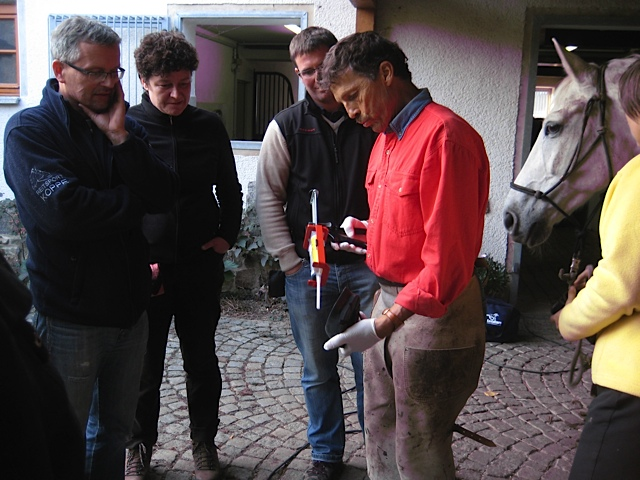 Demonstrating the use of Vettec Glue gun and application of Adhere to the Glue on shells.
Demonstrating the use of Vettec Glue gun and application of Adhere to the Glue on shells.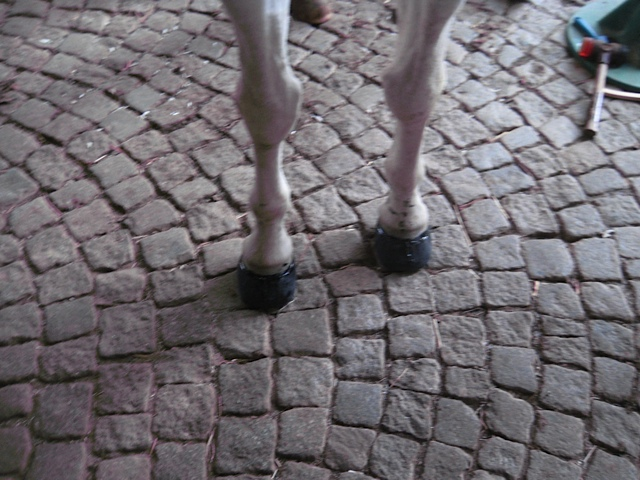 Finished gluing job.
Finished gluing job.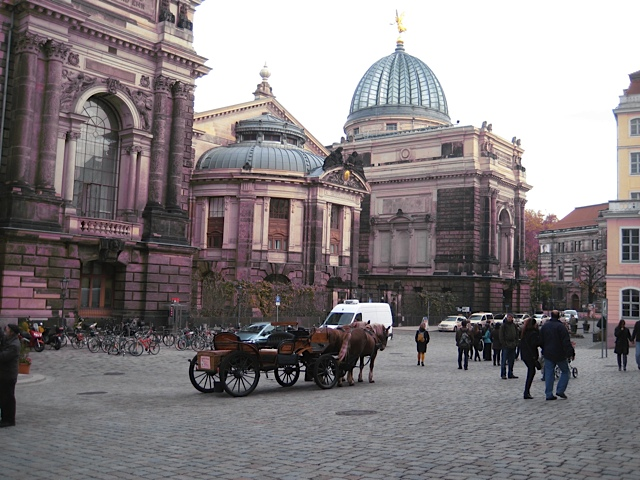
These coaches in downtown Dresden provide visitors a feeling of stepping back in time. After looking at the hoof protection of these carriage horses, we all agreed that they would travel much more comfortably with Easyboots.

Next stop was Hannover. Well known for the Hanoverian breed, this city has a long horse tradition.
The on-site organizing committee had invited over 45 Hoof Trimmers, farriers and veterinarians. After my initial presentation about the different Natural Hoof Care schools and philosophies in the USA and Europe, we discussed NHC and trimming techniques as well as hoof pathologies and remedies. I presented the thesis and studies of Dr. Brian Hampson of Australia, who did the most thorough studies on the hooves of wild horses so far.
If someone were to conduct a study, for example, on the hooves of one herd of wild horses in Nevada or Utah, the two driest states within the USA, where horses have to travel many miles over rocks and sand to find water and food and then propose to use that feral hoof as a benchmark model for healthy hooves for all domestic horses in the world, would that be a realistic and fair conclusion?
Hampson studied and examined hooves from various areas in Australia, wild horses living in arid areas and others in wet areas with lush vegetation. The hooves of the wild horses living in the wetter areas looked a lot like the average domestic hooves. Does that mean the hooves adapt to the environment or are the hooves shaped by the substrate the horse travels over?
An answer to this question might be obtained by looking at the following photos, provided by Brian Hampson.
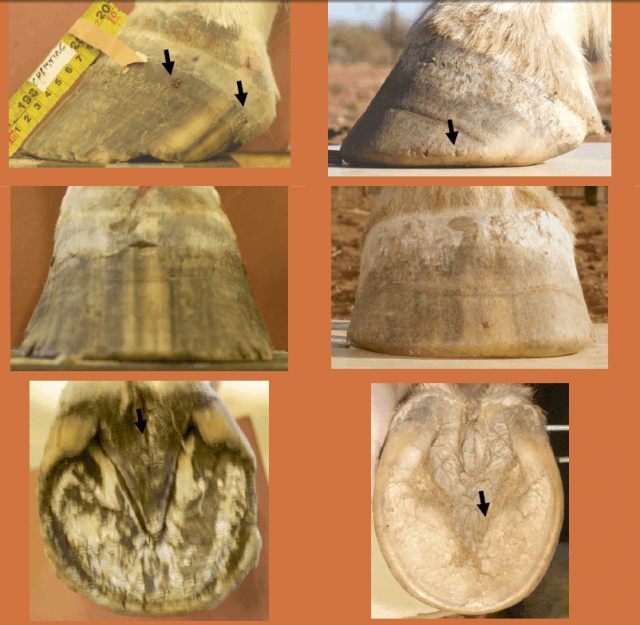

The left hoof has the appearance of a typical domestic hoof. Recessed frog, under-run heels, flares. Yet, it is a wild horse hoof. After moving several horses with these hooves to a different (drier) area, the hooves were remodeled by the ground the horses traveled over. The hoof on the left is void of any mustang roll. Does it not need it? Within 16 weeks the rocks and dry ground reshaped that very same hoof. The mustang roll is clearly visible now. The question might be asked, how important is the mustang roll then, when we as natural hoof care trimmers applying it to all horses, yet only a small segment of wild horses worldwide even display one in the wild?
The study also showed that only three hooves out of 100 assessed were free of abnormalities. In fact, he found a 67% incidence of chronic laminitis within the horses living in the dry climate and the hard substrate. When the majority of the wild horses display this pathology, is it still a pathology or is it physiologically normal now? Who makes these decisions?
Not everything wild is necessarily good solely because it is wild and natural. The wild horse paradigm model of desert horses’ hooves may not be applicable across the board to all horses worldwide.
The discussions were very interesting and we were only scratching the surface of all the ramifications of the Hampson study.
 Discussions of Natural Hoof Care in Hannover.
Discussions of Natural Hoof Care in Hannover.On I went to Kassel, stop for the next seminar.
Similar to the USA, Germany experiences also a shortage of farriers who are willing to offer services beyond the traditional iron shoes. Many do not know about bare hoof trimming and alternate hoof protection like plastic shoes and hoof boots. Therefore, more and more riders and horse owners want to learn to trim their horses’ hooves themselves.
I set up several stations, where people could work on their horses hooves simultaneously. That way, everybody had ample time to practice and learn.
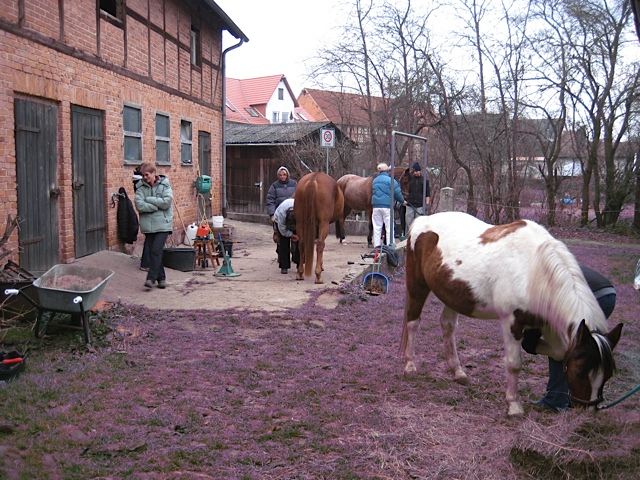 Working at stations.
Working at stations.Onwards to Belgium. near Brussels, I conducted the last clinic. My French is very rusty, to say the least, so everything was translated by Leonard Liesens, a famous and successful Belgian endurance rider.
I learned to speak slowly and to include only essential information in my sentences. And I got my message across as well, without lengthy and repetitive wording. An exercise in disciplining speech.
 The historic Market Place in Brussels.
The historic Market Place in Brussels.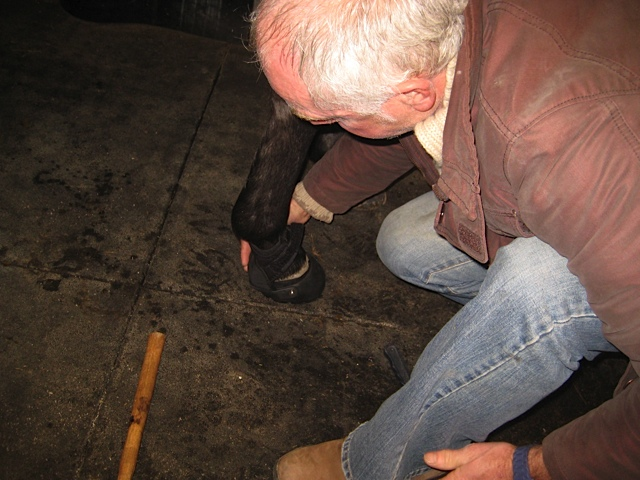 Leonard Liesens checking the fit of the Easyboot Glove he had just applied.
Leonard Liesens checking the fit of the Easyboot Glove he had just applied.At all the seminars, I also showed slides of the Tevis ride. With all the Europeans now coming to Tevis next year, we better all put our entries in early to avoid being placed on the waiting list.
The Europeans were all very eager to learn and try new trimming techniques. They are pragmatic and want to use the trimming and hoof protection that works best for their horses. They do not believe that Natural Hoof Care and Bare Hoof Trimming is an ideology or a mantra. For them, it is not an absolute, rather a better and healthier way to take care of their horses’ hooves. They do not want to listen to self righteous statements of cult-like organizations. The welfare of their horses is important. That is a reason why Pete Ramey stands in such high esteem in Europe, his open mindedness, his tolerance, his knowledge and non judgmental approach to hoof care puts him in a class of his own and a big step above everybody else.
I did stress the importance of looking at each horse as an individual. The trimming procedure that works for one horse, might not be the best approach for the horse right next to it.
Europe has many more horses than the USA. Per capita, Germany has 70% more horses than the USA. Horse owners and riders want to learn and improve and use modern and better hoof protection methods.
Already now, I have booked several more clinics for next spring, this time in addition to Germany also in France and Switzerland. Natural Hoof Care, Barefoot Trimming and Easyboots are on a roll and gaining ground and popularity throughout the whole equestrian world.
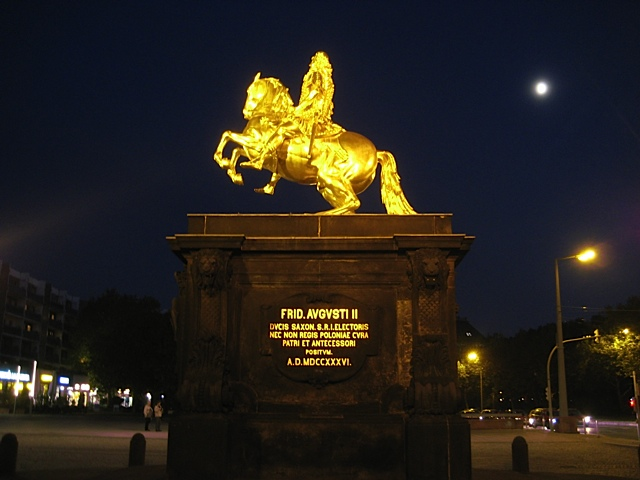 Golden statue of August Der Starke (August The Strong), former King of Saxonia, in Dresden.
Golden statue of August Der Starke (August The Strong), former King of Saxonia, in Dresden.A special Thank You goes out to my liaisons and support persons who organized the events on site. Without them, it would have been very difficult to impossible to conduct the seminars:
Dresden: Veit Koppe
Hannover: Patricia Nastoll and Kathrin Ewen
Kassel: Martin Boesel
Brussel: Leonard Liesens
The Bootmeister, reporting from Europe





